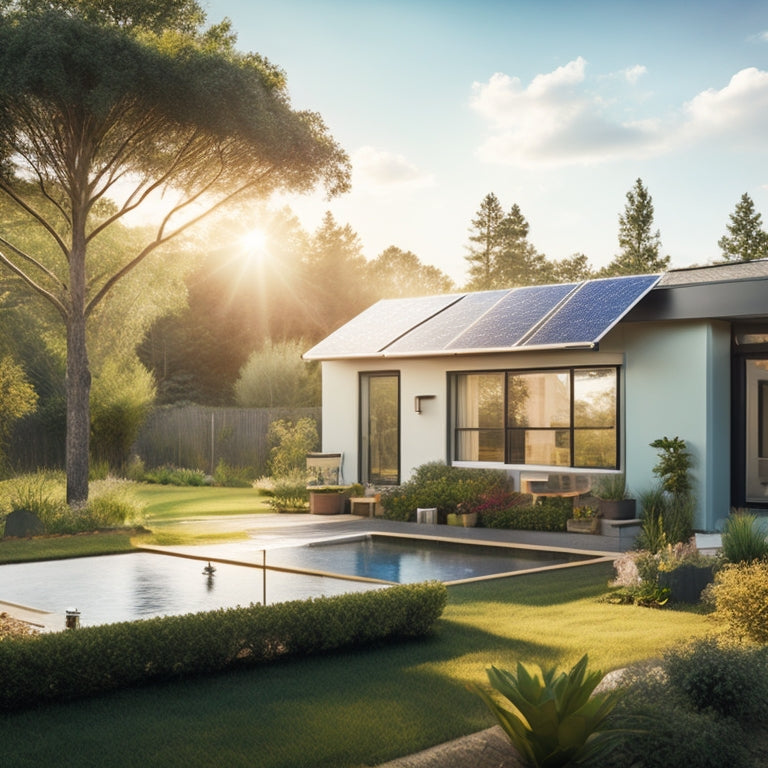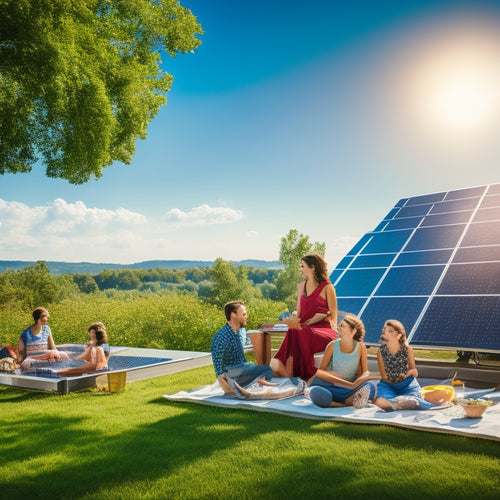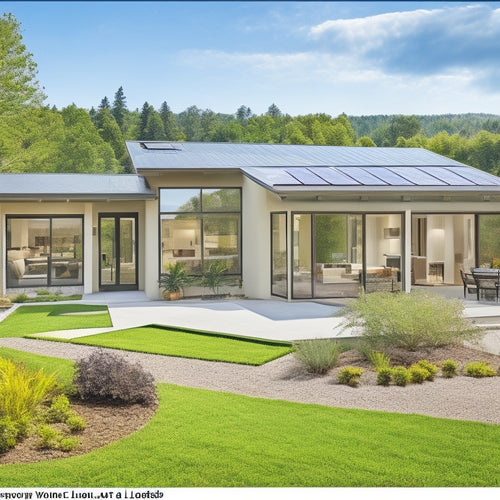
How to Set Up a Home Solar System
Share
You'll start by evaluating your energy needs, reviewing past utility bills and considering energy efficiency ratings of appliances and lighting. Next, you'll choose the right equipment, selecting high-efficiency solar panels that fit your budget and meet your energy requirements. You'll then determine the ideal placement and layout of your solar panel array, considering factors like sunlight exposure, roof size, and local regulations. After sizing your array and selecting a compatible inverter, you'll install the system, connect to the grid, and monitor performance to guarantee maximum energy production. Now, get ready to take a closer look at each step to guarantee a seamless shift to renewable energy.
Key Takeaways
- Assess energy needs by reviewing past utility bills and evaluating energy efficiency ratings of appliances and lighting.
- Choose the right equipment, including solar panels, inverters, and mounting systems, considering factors like budget, energy needs, and warranty options.
- Size the solar panel array correctly by calculating daily energy requirements, peak sun hours, and panel efficiency to ensure optimal energy production.
- Ensure proper installation by conducting a roof compatibility assessment, selecting a suitable mounting system, and following safety protocols and installation regulations.
- Monitor and maintain system performance by tracking energy production, scheduling routine inspections, and utilizing diagnostic tools to identify improvement areas and plan upgrades.
Assessing Your Energy Needs
How much energy do you actually need to power your home? Understanding your energy consumption is essential in determining the right solar system for your needs. Start by reviewing your past utility bills to identify your average energy usage.
Consider factors like energy efficiency ratings of your appliances and lighting to enhance energy consumption. You may also want to investigate renewable incentives offered by your utility company or government, which can help offset the installation costs of your solar system.
Evaluating your energy needs will help you determine the most suitable system size, ensuring you produce enough power to meet your requirements. This, in turn, will impact your long-term savings and energy independence.
Choosing the Right Equipment
You'll need to select solar panels that meet your energy needs and fit your budget, considering factors like efficiency, durability, and warranty.
When sizing your system, you'll need to balance the number of panels with the capacity of your inverter and the available roof space.
Proper system sizing will guarantee you generate the right amount of electricity to power your home efficiently.
Solar Panel Selection
Your solar panel selection is a critical component of your home solar system, as it directly impacts the amount of energy you can generate. With so many options available, it's crucial to contemplate several factors to make an informed decision.
When choosing solar panels, reflect on the following key factors:
-
Solar panel types: Monocrystalline, polycrystalline, and thin-film panels each have their advantages and disadvantages. Monocrystalline panels offer high efficiency, while thin-film panels are more budget-friendly.
-
Efficiency ratings: Look for panels with high efficiency ratings (above 20%) to maximize energy production. However, high-efficiency panels often come at a higher cost.
-
Budget considerations: Set a budget and balance it with your energy needs. More expensive panels may provide better performance, but may not be necessary for your specific situation.
- Aesthetic and installation requirements: Consider the panel's appearance, size, and weight, as well as installation requirements, such as roof size and orientation.
Additionally, think about warranty options, brand comparisons, and the environmental impact of your chosen panels.
System Sizing Considerations
Frequently, homeowners underestimate the importance of system sizing considerations, which can lead to inefficient energy production and a lower return on investment.
When choosing the right equipment for your home solar system, it's essential to evaluate the size of your system. You'll need to determine how much energy you want to produce, factoring in your energy efficiency goals and local regulations. Financing options and installation costs will also impact your system size decisions.
Battery storage is another key factor, as it allows you to store excess energy generated during the day for use at night or during power outages.
You'll also want to assess the environmental impact of your system, including the type and quality of equipment you choose. System warranties, grid integration, and maintenance schedules are also significant elements to assess.
Don't forget to investigate tax incentives that can help offset the cost of your system. By carefully evaluating these factors, you can optimize your system size for maximum energy production and financial returns.
Determining Solar Panel Placement
Most homes have several potential locations for solar panel installation, but not all of them are created equal.
When determining the best placement for your solar panels, you'll need to take into account several factors that impact energy production and overall system performance.
Here are 4 key factors to keep in mind:
-
Sunlight exposure and shading analysis: Confirm the location receives sufficient sunlight throughout the day, considering any obstructions like trees, buildings, or roof features.
-
Roof angle and orientation impact: The ideal roof angle is between 30-40 degrees, and the orientation should be within 15-20 degrees of true south to maximize energy production.
-
Structural integrity and maintenance access: Verify the roof can support the weight of the solar panels and guarantee easy access for maintenance and repairs.
- Local regulations, aesthetic considerations, and neighbor considerations: Comply with local building codes, reflect on the visual impact on your home, and be mindful of any potential issues with neighbors.
Sizing Your Solar Panel Array
You'll need to determine the size of your solar panel array based on your energy requirements, which involves calculating how many panels you'll need and how they'll be arranged.
To do this, you'll assess your energy usage, considering factors like your appliances, lighting, and HVAC system.
Assessing Energy Requirements
Determining the size of your solar panel array is essential to meeting your energy requirements. To do this, you need to assess your energy consumption patterns and identify areas where you can optimize energy efficiency.
You should consider the following key factors:
-
Peak usage times: When do you use the most energy in your home?
-
Household appliances analysis: Which appliances consume the most energy?
-
Lifestyle energy habits: Are there any changes you can make to reduce energy consumption?
- Future energy needs: Do you plan to add more appliances or family members in the future?
Calculating Panel Quantity
As you've assessed your energy requirements, now it's time to translate those needs into a physical solar panel array. To do this, you'll need to calculate the number of solar panels required to meet your energy demands. This involves considering factors such as solar panel efficiency, energy production, and your available roof space.
First, determine the total daily energy requirement in watt-hours (Wh) based on your previous assessment. Then, divide this value by the peak sun hours (PSH) your location receives daily. Peak sun hours represent the amount of solar energy available per hour. This calculation will give you the required system size in watts (W).
Next, consider the efficiency of the solar panels you plan to use. Most commercial panels have an efficiency rating between 15% and 20%. Divide the required system size by the panel efficiency to determine the total panel area needed.
Determining Array Layout
With your required system size and panel area in hand, it's now crucial to translate these calculations into a physical solar panel array, taking into account the space constraints of your roof. This involves determining the ideal array layout to maximize energy production while minimizing potential losses.
To achieve this, you'll need to take into account the following key factors:
-
Array orientation: The direction your solar panels face can greatly impact energy production. Ideal orientations vary by location, but generally, a south-facing orientation is best.
-
Shading analysis: Identify potential shading sources, such as trees, buildings, or roof features, and plan your array accordingly to minimize energy losses.
-
Roof layout and obstacles: Factor in roof vents, skylights, and other obstructions that may affect your array's placement and performance.
- Panel configuration and spacing: Balance panel density with adequate spacing to guarantee ideal airflow and reduce heat-related losses.
Selecting a Compatible Inverter
Your solar panel array's electrical output is only as good as the inverter that converts it into usable AC power for your home. You'll need an inverter that's compatible with your array's voltage and power output.
There are three main inverter types: string inverters, microinverters, and power optimizers. String inverters are the most common, but microinverters offer more flexibility and monitoring capabilities. Look for an inverter with high efficiency (above 95%) to minimize energy losses.
Inverter warranties typically range from 10 to 25 years, so choose a reputable brand like Enphase, SMA, or Fronius. Verify the inverter is compatible with your solar panel brand and model.
Consider inverter features like monitoring, grid-tie functionality, and ground fault protection. Placement is vital, as inverters should be installed in a well-ventilated area, protected from extreme temperatures and moisture.
Inverter costs vary, but expect to pay between $0.10 and $0.30 per watt. Be prepared for inverter troubleshooting, which may require professional assistance.
Research and compare inverter options carefully to guarantee a seamless and efficient solar power system.
Installing the Solar Panel System
Installing the Solar Panel System
The solar panel system installation process begins with a thorough assessment of your roof's structural integrity and suitability for solar panels. This assessment is critical to guarantee that your roof can support the weight of the solar panels and that the panels will be installed at an ideal angle to maximize energy production.
To guarantee a successful installation, consider the following key factors:
-
Roof compatibility assessment: Evaluate your roof's age, condition, and material to determine if it's suitable for solar panels.
-
Solar panel placement: Identify the best location for your solar panels to maximize energy production, considering shading, orientation, and obstructions.
-
Mounting system selection: Choose a mounting system that's compatible with your roof type and guarantees secure and durable installation.
- Solar installation techniques: Familiarize yourself with the latest solar installation techniques to guarantee a safe and efficient installation process.
Connecting to the Grid
Once you've successfully installed your solar panel system, it's time to connect it to the grid, allowing you to feed excess energy back into the electrical grid and offset your utility bills.
To do this, you'll need to meet your utility's requirements for grid connection, which typically involves an interconnection process that guarantees your system meets safety protocols and installation regulations. This process usually includes a series of inspections and approvals from your utility company.
Net metering allows you to generate your own electricity and export any excess to the grid, earning you energy credits in the process.
As part of the connection process, you'll need to install specialized equipment that monitors your system's performance and guarantees safe and reliable operation. This equipment will also provide you with real-time data on your energy production and consumption, helping you optimize your system's performance.
Monitoring and Maintaining Performance
With your solar panel system connected to the grid, you're now generating your own clean energy and offsetting your utility bills.
To guarantee your system continues to perform at its best, it's crucial to monitor and maintain its performance.
Here are four key aspects to focus on:
-
Performance monitoring: Regularly track your system's energy production to identify any deviations from expected output. This helps you pinpoint potential issues before they escalate.
-
Routine maintenance: Schedule regular inspections and cleaning of your solar panels to maintain energy efficiency and prevent damage from debris or environmental factors.
-
System diagnostics: Employ built-in diagnostic tools or remote monitoring systems to detect and troubleshoot issues promptly, reducing downtime and maximizing performance optimization.
- Data analysis and upgrades: Analyze your system's performance data to identify areas for improvement and plan for future upgrades, guaranteeing your system remains efficient and effective throughout its equipment longevity.
Frequently Asked Questions
Can I Install a Solar System Myself Without Professional Help?
You can attempt a DIY installation, but it's vital to understand solar panel types, electrical connections, and local building codes to guarantee a safe and efficient system; however, professional help is often recommended to avoid costly mistakes.
How Long Does It Take for a Solar System to Pay for Itself?
You'll recoup your solar system's cost through financial savings in 5-7 years, depending on your energy usage and local incentives, after conducting a thorough cost analysis to determine your breakeven point and maximize returns.
Are There Any Government Incentives for Installing Solar Systems?
Installing solar systems is like planting a money tree - it pays you back! You're eligible for government incentives, such as tax credits and solar rebates, which can greatly reduce your upfront costs, making your investment bloom with savings.
Can I Use Solar Power to Charge My Electric Vehicle?
You can utilize solar power to charge your electric vehicle, utilizing a dedicated solar charging station or your home's solar panel system, ensuring a sustainable and eco-friendly fueling solution that reduces your carbon footprint.
Will My Solar System Still Work During a Power Outage?
You'll be glad to know your solar system remains operational during a power outage, ensuring reliability, thanks to a backup battery or generator, which stores excess energy for later use, guaranteeing power outage preparedness and uninterrupted electricity supply.
Conclusion
As you flip the switch, it's not just the lights that come on - it's a sense of independence from the grid and a commitment to a cleaner future. Coincidentally, the same sunlight that powers your home also illuminates the potential for long-term savings. With your new solar system up and running, you can now track your energy production and monitor your progress towards a more sustainable tomorrow.
Related Posts
-

Solar Power Savings for Environmentally Aware Consumers
Switching to solar power lets you drastically cut your carbon footprint while saving money in the long run. Each kilo...
-

How to Reduce Home Energy Bills
To reduce your home energy bills, start by investing in energy-efficient appliances and upgrading your insulation. Lo...
-

Passive Solar Design Strategies for Homes
To effectively implement passive solar design strategies in your home, focus on ideal building orientation and strate...


